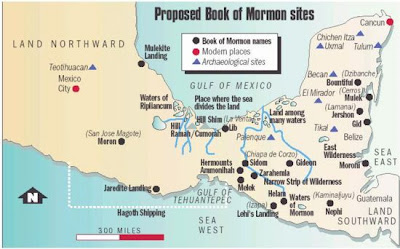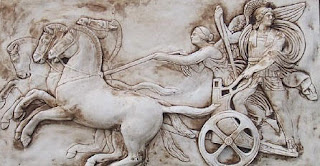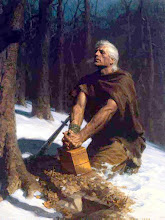
Ancient Mesoamericans made a type of “cement” out of limestone. It was then used as a plaster overcoat on top of rubble and stonework. Here are a couple of paragraphs from the book Life in the Ancient Maya World, by Lynn V. Foster, that explains:
“The Maya constructed cities with complexes that could cover many football fields and pyramidal ones that rose to heights of 70 meters (231 feet), yet they built their cities with Stone Age technology. No steel beams supported pyramids or vaults, no metal tools were available to quarry stone or to carve it. Instead, wooden beams, stone, and lime cement were the structural building blocks; rope-and-water abrasion and stone and obsidian tools provided the basic technology of Maya cities. (238)
Lime Plaster and CementLimestone was burned under intense heat to make plaster, or stucco, and cement. To make a small pile of plaster (0.9 meters, or 3 feet high), 20 trees had to be felled and burned. Plaster on exterior walls weather poorly, so little is recovered during excavation. There is enough evidence, however, to indicate that some buildings were colored red or cream by the addition of either iron oxide or organic materials to the plaster. Lime cement was used as mortar or fill at many sites, including Palenque and Uxmal. (239)
The following verses in the Book of Mormon refer to cement, and, according to apologists, caused criticism in the past:
THE BOOK OF HELAMAN
CHAPTER 3
Many Nephites migrate to the land northward—They build houses of cement and keep many records—Tens of thousands are converted and baptized—The word of God leads men to salvation—Nephi the son of Helaman fills the judgment seat. Between 49 and 39 B.C.
4 And they did travel to an exceedingly great distance, insomuch that they came to large bodies of water and many rivers.
5 Yea, and even they did spread forth into all parts of the land, into whatever parts it had not been rendered desolate and without timber, because of the many inhabitants who had before inherited the land.
6 And now no part of the land was desolate, save it were for timber; but because of the greatness of the destruction of the people who had before inhabited the land it was called desolate.
7 And there being but little timber upon the face of the land, nevertheless the people who went forth became exceedingly expert in the working of cement; therefore they did build houses of cement, in the which they did dwell.
Apologists believe that this is a significant “hit” for the Book of Mormon. They claim that cement appeared ‘suddenly’ in ancient Mesoamerica around 100 AD.
“The use of cement appears abruptly in Mesoamerican archaeology around the first century A.D., as, for example, in these cement buildings at Teotihuacan in the Valley of Mexico. The Book of Mormon states that some Nephite dissenters who moved in a land northward “became exceeding expert in the working of cement” and “built cities of both wood and of cement” beginning in 46 B.C. (Hel. 3:7, 11). Courtesy John W. Welch.”
In reality, the use of limestone cement as a plaster overlay was used long prior to that period, and prior to Teotihuacan’s famous use of it. The only reason the BoM apologists want to connect Teotihuacan to the cited scriptures is due to the noted “lack of trees”. Teotihuacan did, indeed, experience an ecological catastrophe that probably contributed to its demise around 500 AD. However, there are problems with trying to connect this to Helaman.
One – Helaman notes the construction of cement cities as an unusual phenomenon. Yet the use of limestone plaster was in use long before this date. In one of the earliest Mesoameican cities, Nakbe, demonstrated the architectural style:
Complex societies flourished in the Petan region during the Middle to late Formative Period (600/500-300 BC). Monumental architecture was established in Nakbe as early as the 8th century BC. By 750 BC Nakbe had some structures that reached the height of 20 meters (66 feet) high. By 800 BC, Nakbe had grown to extend to over 50 hectars (124 acres). During this time the city replaced its collection of low platforms of rough stones surmounted by wattle-and-daub structures with a number of high platforms and temples covered in plaster.
Wiki
Two – the BoM has the cause/effect reversed. In Teotihuacan, it was the excessive use of limestone plaster that CAUSED the deforestation, due to the high number of trees needed to produce the prerequisite heat.
Teotihuacan at the Time of the Fall
In dividing up the chronology of Teotihuacan, archaeologists identify the last two periods as being the Xolalpan Phase (A.D. 450-650) during which time the city reached dizzying heights in art, architecture, and cultural influence, and the Metepec Phase (A.D. 650-750), during which time the Empire went into sharp decline before it suddenly and mysteriously combusted.
Scholar G. C. Valliant wrote of the final period of Teotihuacan, that "Teotihuacan was built over hastily with the maximum use of original construction. The abrupt change in figurine styles suggests new gods were being honored. The drain on human resources implicit in such large scale construction, would lead readily to revolt under the strain"20. Villiant was also the first to suggest that the massive deforestation of the surrounding area to produce limestone caused the drying up of streams and erosions of fields, ruining the surrounding farmland.”
Third – as seen in the link above, Teotihuacan actually was at its prime in 450-650 AD. The problematic deforestation occurred past the BoM time period. BoM apologists Brant Gardner attempts to “correct” this problem by asserting that the editor Mormon engaged in “presentism” by inserting information about Teotihuacan from HIS time period into the ancient text, and there is no way the authors of Helaman would have actually known about this area in the first place. This is completely unsupported by the text, and moreover, even this time adjustment does not put the severe deforestation in the right BoM time period.
Mormon and TeotihuacanPeople during JS’ period were aware of the astounding discoveries in Central America. The pyramids were receiving press already by that period. In addition, other authors of JS’ time period implied the use of similar materials. An example can be found in the Spalding Manuscript, as noted here:
“28. Some modern building methods were used. MS -- The inside of the walls of the houses of the Ohons "were formed of clay, which was plastered over with a thin coat of lime" The chimney of their fireplaces were built of split timber on the inside "(with wet dirt or clay) of which they plaster, dirt or clay -- which compleatly covers & adheres to the timber & prevents the fire from having any operation upon it." (p. 23) BM -- "And there being but little timber upon the face of the land, nevertheless the people who went forth became exceedingly expert in the working of cement; therefore they did build houses of cement, in which they did dwell." (Helaman 3:7) Cf. also Helaman 3:9, 11. 9
Comment summary on item #28: ** It is probably incorrect to view the structures and building methods of either source as being exclusively "modern." About the only Spalding building element that would be an out-of-place addition to known pre-Columbian homes would be his fireplace with a draft chimney. But this is not found in Book of Mormon structures. The "cement" mentioned in the Book of Mormon may have been similar to Spalding's "plaster," but such building materials were known in the ancient Americas (see also Bown's item #29).
28. Some modern building methods were used. Full comments on item #28: It is probably incorrect to view the structures and building methods of either source as being exclusively "modern." About the only Spalding building element that would be an out-of-place addition to known pre-Columbian homes would be his fireplace with a draft chimney. But this is not found in Book of Mormon structures. Exactly what the Book of Mormon writer meant by the word "cement" is unclear. Presumably he did not mean reinforced concrete construction, but rather the cementing of stones to produce structural walls. Joseph Smith, jr. used the term with this general meaning when he spoke of finding a cemented stone box of Nephite construction. Structures built of cemented stone, plastered over on the outside and roofed with wood, sod, or additional rock work could have been erected by Book of Mormon peoples and Spalding's Ohians with equal ease. The civilized peoples of both accounts appear to have reached about the same level of technology and both would have generally had the same building materials to work with. Bown is thus incorrect in seeing this type of building as being exclusively "modern." Primitive cement can be made from a mixture of ground limestone, sand, clay and a bit of vegetable fiber. Such a material would weather and deteriorate in most climates, leaving little evidence in the
archaeological record.
29. Some of the people built houses of wood. Full comments on item #29: If Bown meant this generality to serve as a parallel, he should have said something similar to my comments given for his item #28. It is a bit unclear whether Book of Mormon peoples built houses of wood and houses of cement, or whether they built some houses exclusively out of wood and others of both wood and cement. Houses like those described by Spalding, built of plastered wood, could easily be essentially the same as structures built both of wood and cement. Perhaps Book of Mormon "cement" was little more than a structurally stronger version of Ohian "plaster." At any rate, pre-Columbian houses of Spalding's exact type have never been uncovered. These fictional structures probably find their closest real equivalents in some of the highland constructions of ancient South America.”Aside from the Spalding manuscript, the Mound Builders also used plaster, and remnants from this ancient culture were being discovered during Joseph Smith’s time period and area. Here’s one example:
Evidences of the work of these people are found in many of the eastern states and as far south as Tennessee in great abundance. The mounds are numerous along the Mississippi Valley in Iowa, extending from Dubuque at intervals through Jackson, Clinton, Scott, Muscatine, Louisa and other counties. Many of these when opened are found to contain skeletons partially preserved,
with various implements, vessels, pipes and ornaments. One opened near Dubuque disclosed a vault divided into three cells. In the central cell
was found eight skeletons sitting in a circle, while in the centre of the group was a drinking vessel made of a sea shell. The whole chamber was covered with logs preserved in cement.







